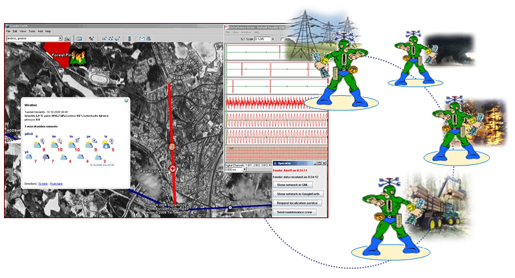|
Deliverable 3.2
SmartResource Platform in Distributed Power Networks Maintenance

It is noticeable that the operation centers of different companies have no connection to each other,
so information exchange among them is nearly impossible. In the case of a fault affecting two different sub-networks,
such information exchange, though, may be very important, for all of fault localization, network reconfiguration,
and network restoration. Introducing an inter-organizational SmartResource platform could solve this issue.
The information flow will go through the agents representing the sub-networks on the SmartResource platform.
Utilization of Semantic Web technologies will allow such interoperability even if the sub-networks use software systems
from different vendors (ABB is not the only one), and thus maybe different data formats and protocols.
The second scenario in our vision is related to a new business model that ABB could implement.
At present, all ABB expertise gets embedded into hardware or software systems and sold to the customers as it is.
A new business model would be to start own Web-service providing implementation of certain algorithms, so the ABB
customers will utilize those algorithms online when needed. ABB will be always able to update algorithms, add new,
and so on. SmartResource platform will ensure interoperability and coordination between such Web-service and customers'
software systems, and also a relative ease of implementation of such a solution - because it will not require changes
in existing software systems, only extension with the SmartResource platform. Noticeable that, if semantically defined,
such Web-service can potentially be utilized across the globe even by the customers who never purchased any of ABB hardware
or software.
The third scenario in our vision is related to the possibility integrating data, which is currently
utilized in the power network management (network structure and configuration, feeder relay readings), with contextual
information from the external sources. Such integration can be used for:
Risk analysis. Information about whether conditions, ongoing forest works,
or forest fires can be used for evaluating existing threats for the power network. This may be used to trigger an
alert state for the maintenance team, or even to do a precautionary reconfiguration of the network to minimize
possible damage.
Facilitation of fault localization. The output of fault localization algorithms
is not always certain. The information about threats for the power network that existed at the time when the fault
occurred (which thus may have caused the fault) may greatly facilitate the localization. In some situations,
contextual information alone may even be sufficient for localization.
Operator interface enhancement. Contextual information may be used also just to
extend the operators' view of the power network. For example, satellite imagery can be used for geographic view
(instead of locally stored bitmaps as it is in the current DMS); also, dynamically-changing information can be accessed
and represented on the interface.
The last scenario is our vision is about the possibility of transferring the knowledge of human experts
to automated systems, by means of various data mining tools. In the power network management case, one scenario that seems
to be highly appropriate for such knowledge transfer is the following. In present, it is always a decision of a human expert
which of the existing fault localization algorithms will perform the best in the context of the current configuration of the
power network and the nature of the fault. Such decisions made by an expert along with the input data could, be forwarded to
a learning Web-service. After a sufficient learning sample, this Web-service could start to be used in some situations
instead of the human expert, e.g. in situations when a faster decision is needed or when the expert is unavailable.
|
|
|

